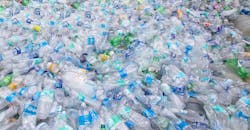Army Explores Discarded Plastic Containers as Feedstock for 3D printers
Researchers at the Army Research Laboratory have taken recycled polyethylene terephthalate (PET) from bottles and plastics without any chemical modifications or additives and used it as the material in a fused filament fabrication (FFF filament), one of the many types of 3D printing.
Recycled PET was shown to be a viable new feedstock, with mechanical properties of printed parts comparable to those of parts made from commercial filaments, as long as it is cleaned and dried. The researchers tested the new material on both small parts and several larger long lead military parts. In terms of mechanical properties, most polymers used for FFF have bulk strengths between 30 and 100 MPa. Recycled PET has an average strength of 70 MPa, and thus may be a suitable 3D printing feedstock.
Mechanical testing, including uniaxial tensile and three-point bending experiments, were conducted in the laboratory. In these tests, the tensile strength of 3-D printed recycled PET was compared against commercial filaments and found to have similar strength. In addition, a custom test fixture was made to test a 3D printed radio bracket (a long-lead military item). Brackets made of recycled PET failed at a similar load to brackets printed out of commercial ABS filament. This shows that recycled PET filament are strong enough to replace commercial filament in printing a wide range of plastic parts.
The U.S. Army Research Laboratory and the U.S. Marine Corps work together to turn waste plastics—such as water bottles, milk jugs, and yogurt containers—into feedstock for 3D printing parts soldiers may need on the battlefield. (U.S. Army photo)
But recycled polymers contain a variety of additives, fillers, and dyes, and may have gone through different processing, even for the same type of polymer. So, to back up the mechanical testing, the recycled plastics underwent chemical analysis, thermal stability tests, and a host of other tests.
According to the DoD, PET plastics such as water bottles and packaging are one of the most prolific wastes found on battlefields. Both U.S. and coalition forces generate large volumes of it. Being able to repurpose it by printing useful parts on location by soldiers on the front could reduce the logistic burden of transporting parts to forward bases and the costs of disposing of the recyclable material.
The research will let U.S. forces 3D print replacement parts on demand, says the Army. This will increase the readiness of their equipment, but also let them make mission-specific devices in the field.
Each unit currently carries large stockpiles of spare parts for emergencies, but this is costly and increases the risk to warfighters when transporting those parts. It is also difficult to predict the failure and lifecycle of the parts.
The researchers are building a mobile recycling facility to let soldiers use recycled plastics for 3D printing. It will be housed in a 20-ft ISO container, with all equipment and tools needed to fabricate 3D printing filament from plastic waste. The researchers are also looking at filaments from other recycled plastics as feedstocks for 3D printing.


